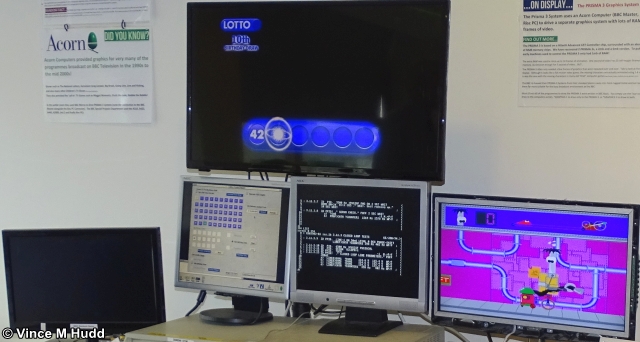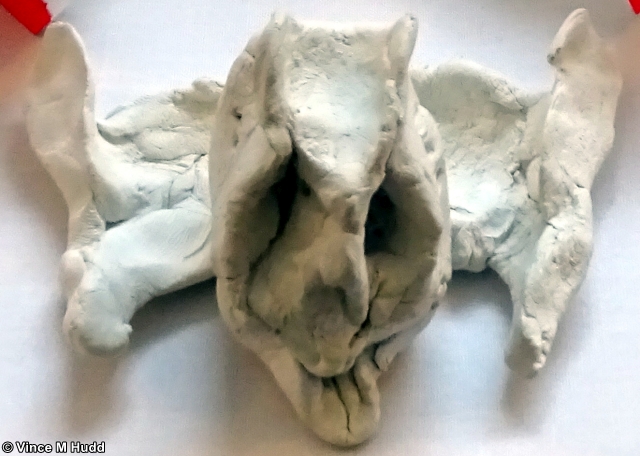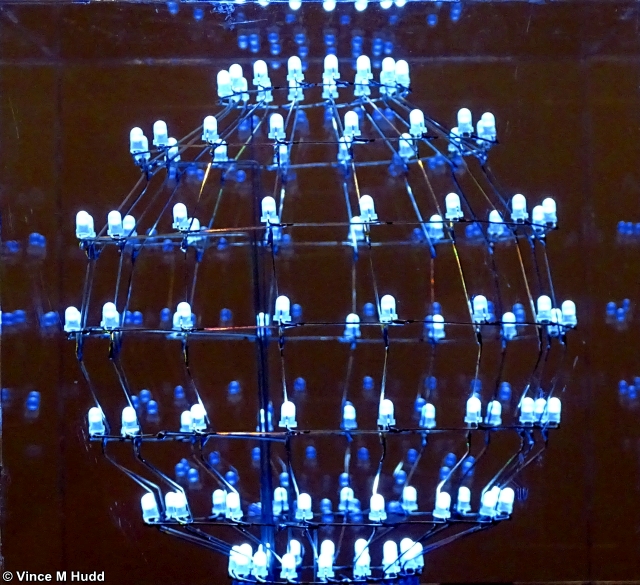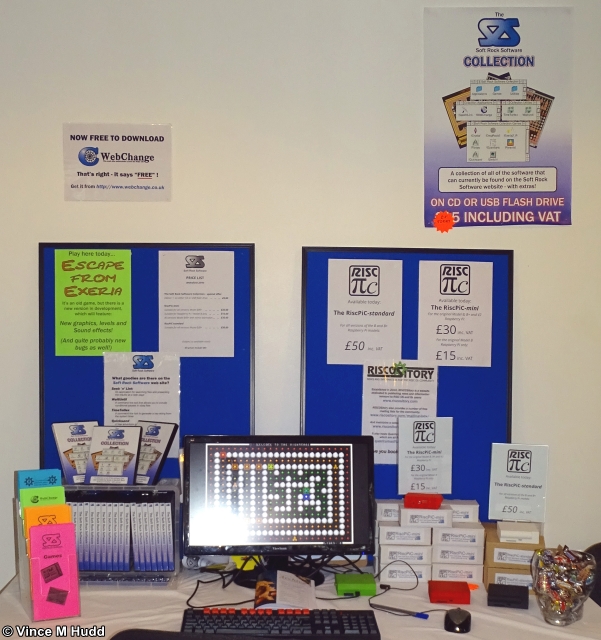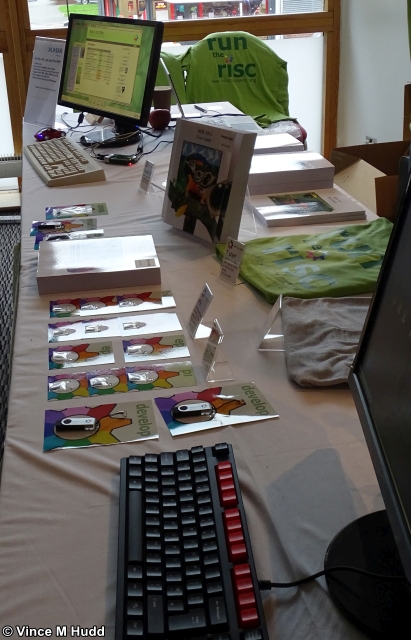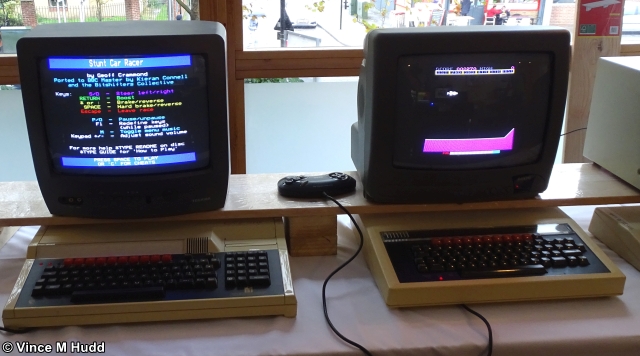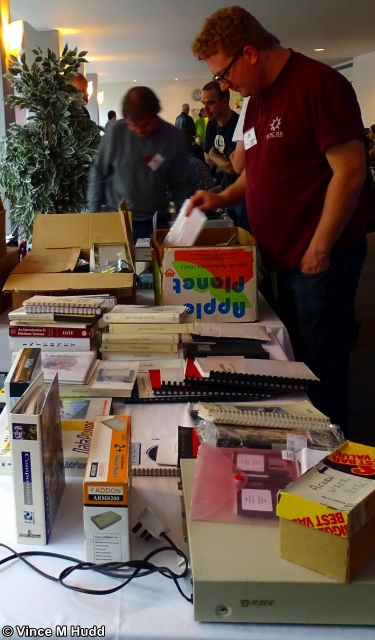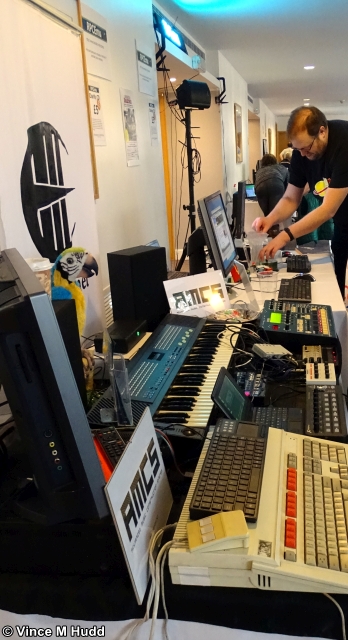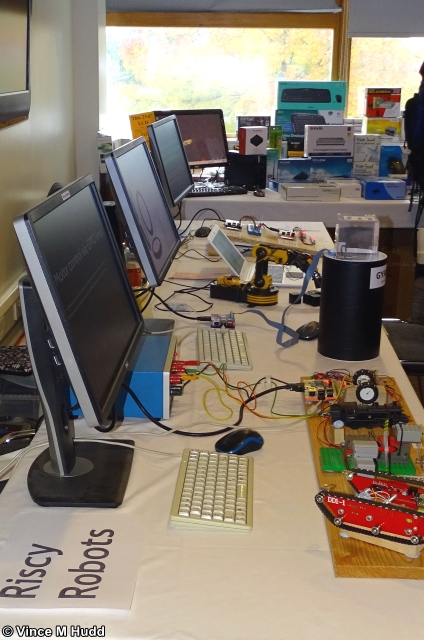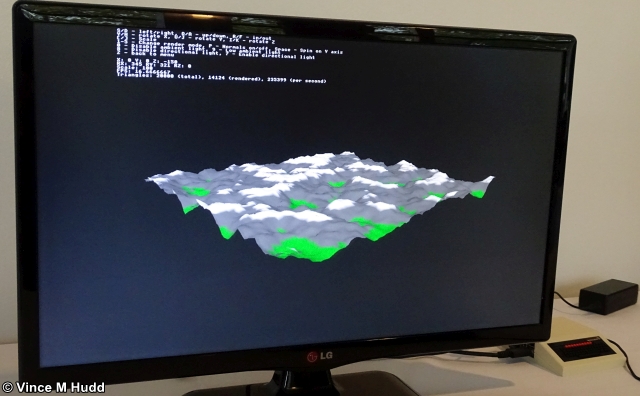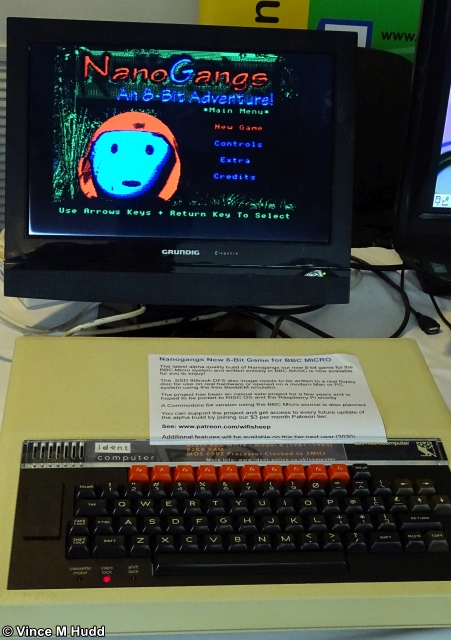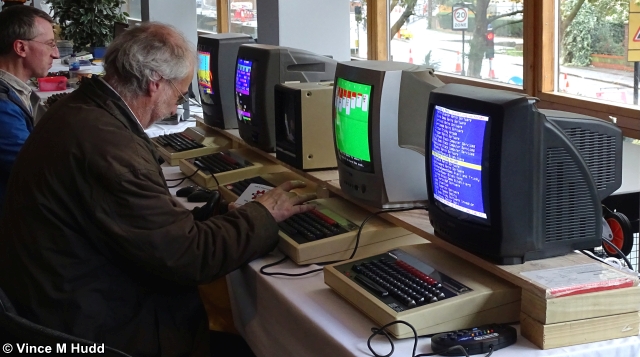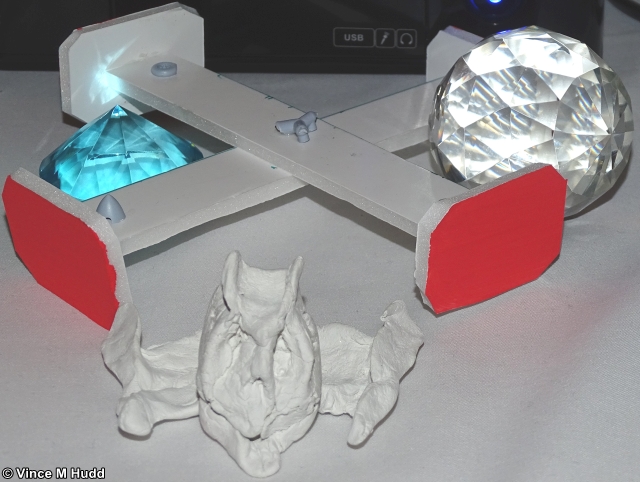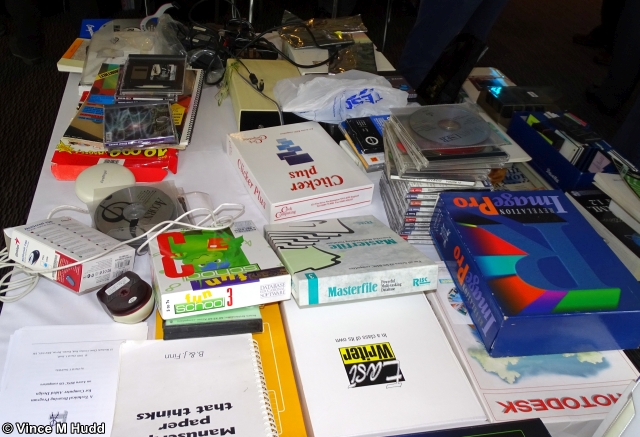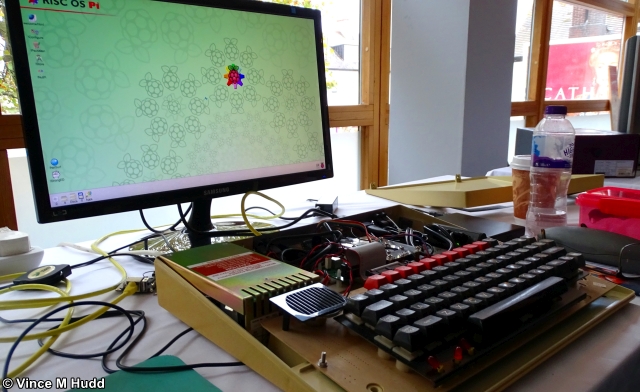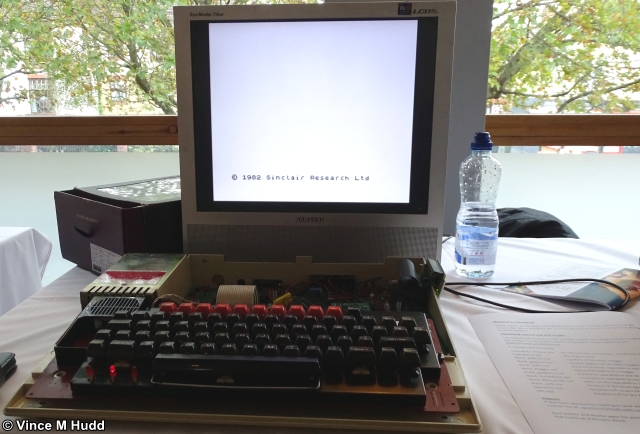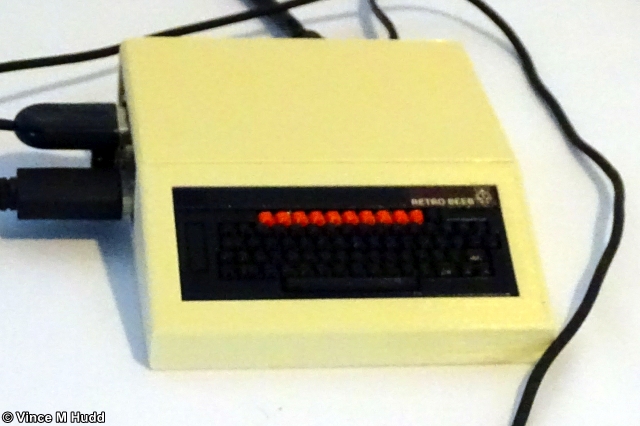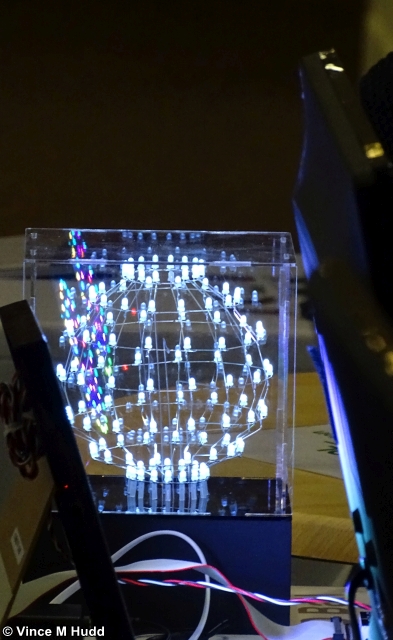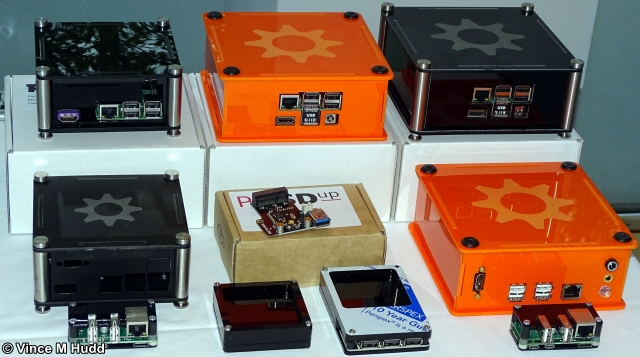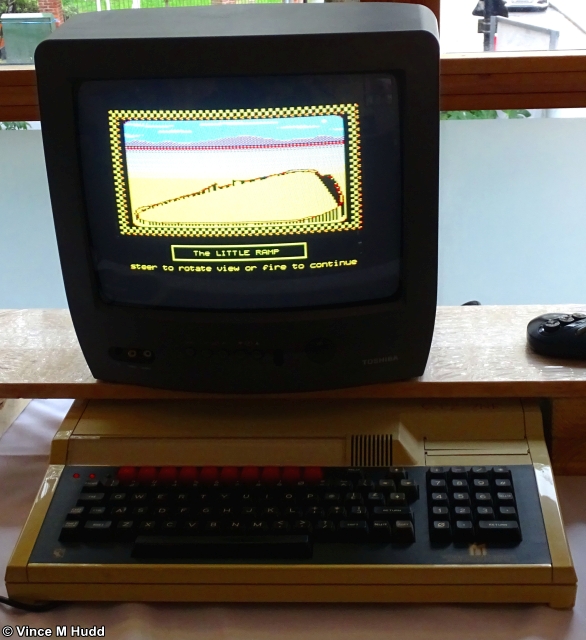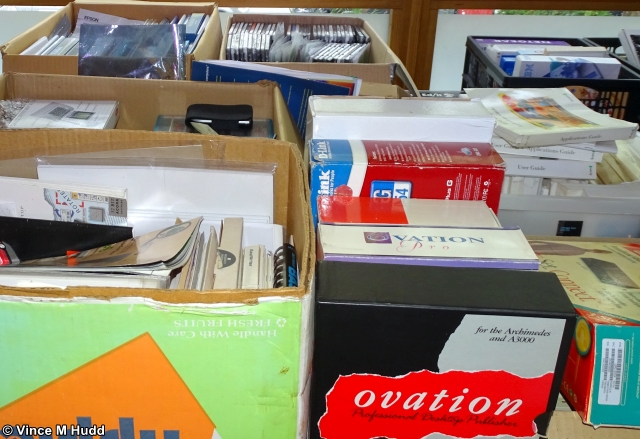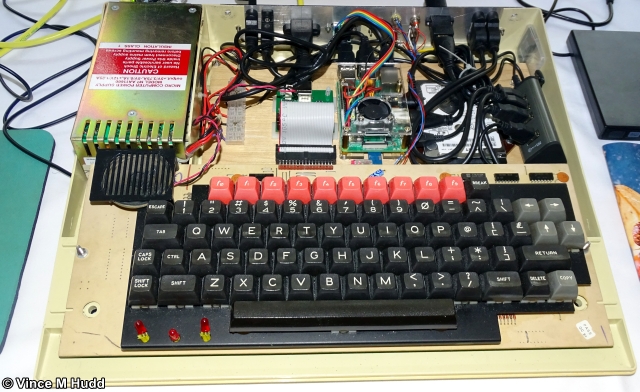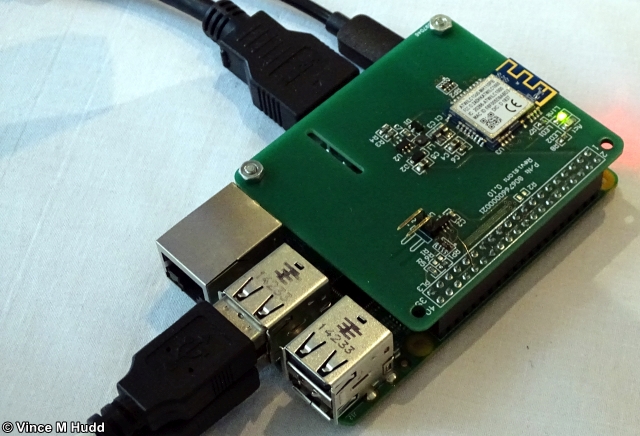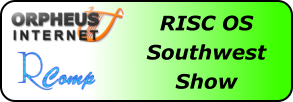The 2019 RISC OS London Show took place on Saturday, 26th October – and once again (speaking as an exhibitor) seemed to be a buzzing, exciting show with plenty for the visitor to see and experience. It was the 11th London Show, with the first having taken place on 3rd October, 2009, and there was a good mix of exhibitors including large well known RISC OS names and smaller home-based operators. As well as many well known faces there were new ones as well, which is always welcome – and always a good sign for the platform.
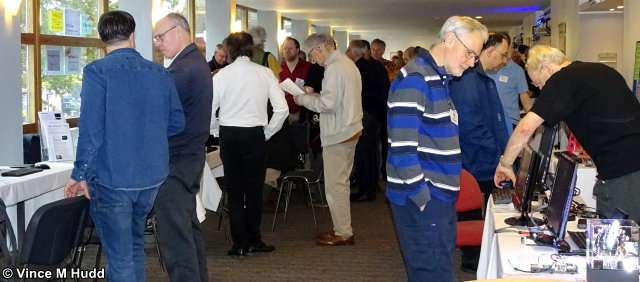
This year, the show-proper occupied the large, main room and one of the side rooms on the first floor of its regular home, the St Giles Hotel, Feltham, and the show theatre was set in another of the side rooms, with the third used as a space for people to take some respite from the hustle and bustle of the day. This report will follow an anti-clockwise path around the show, starting and ending at the entrance, and nipping into the side-room at the appropriate point.
RISC OS User Group of London (ROUGOL)
After handing over a crisp fiver at the ticket desk, the first exhibitor was the group that organises the event each year – the RISC OS User Group of London.
The obvious purpose of any user group at a RISC OS show is to promote membership and attendance at its meetings – and ROUGOL’s meetings more often than not feature a guest speaker, with topics covering not only software or hardware that is aimed at the RISC OS community, but sometimes topics that are tangentially relevant, but interesting nonetheless.
As well as pushing their own meetings, the stand was also used to exhibit some of Andrew Conroy’s flashy flashing projects, while Andrew himself was busy on the CJE Micro’s stand (which we’ll get to later). For this show he had brought along a pair of annoyingly punctuated Blinkt! boards, a Mote strip, a set of DotStar LEDs, and a Borg Sphere LED Ball, all of which were lighting up the ROUGOL stand with various sequences and light shows.
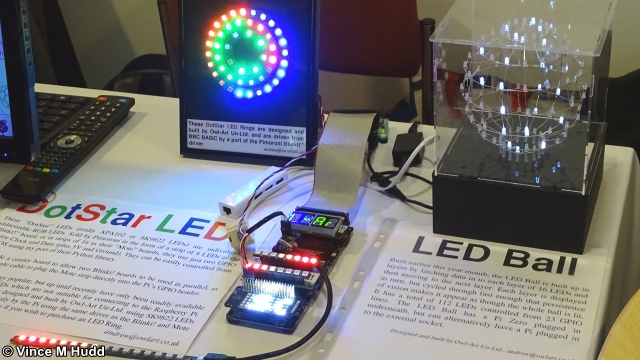
Released shortly before the show, ROUGOL were also making use of the latest toy from Elesar Ltd – a Wi-Fi HAT for the Raspberry Pi, allowing RISC OS on the Pi to connect to a network wirelessly. However, since Elesar’s Rob Sprowson was on the RISC OS Open Ltd stand, this will be covered in more detail later in this report.
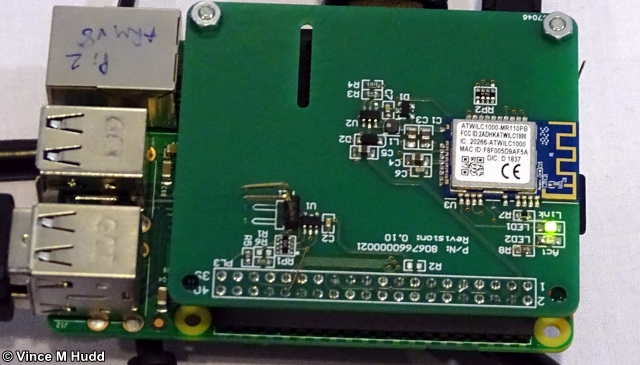
Soft Rock Software
Next up was my stand – primarily promoting Soft Rock Software, but also RISCOSitory, and Bristol RISC OS Users (my own local user group).
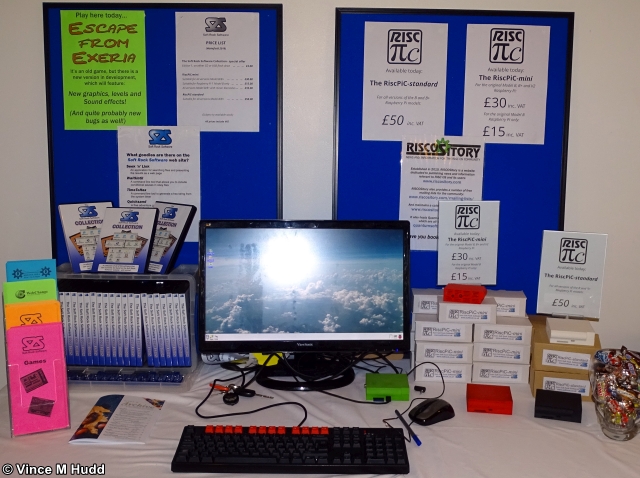
As Soft Rock Software, there were a number of products available to see and buy. The remaining stock of RiscPiC cases were available in both the original -mini and the newer -standard sizes – both of which fit all B and B+ variants of Raspberry Pi except the newest version 4 board, due to the change from a single, standard HDMI socket to dual micro-HDMI sockets. Usefully, I found out at the show that a Pi with Elesar’s Wi-Fi HAT attached still fits neatly in the cases, with further confirmation later.
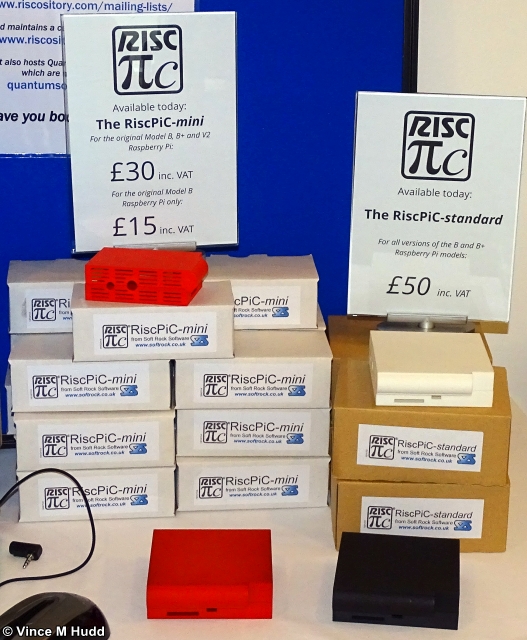
Also available was the first edition of the Soft Rock Software Collection, available on either CD or on a USB flash drive. This contains all of the software currently available for download from the main website, along with a number of extra titles listed on the site but not (yet) available for download – and many of these in multiple versions, to maximise the range of machines on which they can be run.
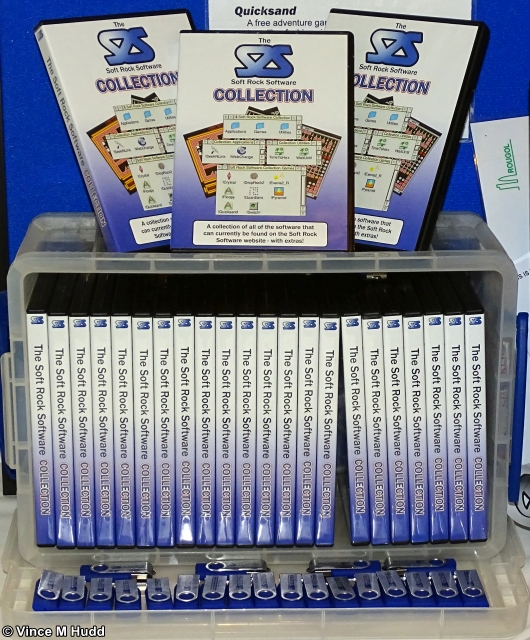
Representing RISCOSitory, I was discussing the very site on which you are reading this report, as well as the mailing lists provided on the sister domain, and the software archived on behalf of Stuart Halliday (Quantum Software). I also now have an archive of Richard Ashbery’s ArtWorks website, for which the original hosting has ended and Richard is no longer planning to maintain, and I will be archiving the content from it in a similar way as and when time allows me to do so.
I was also discussing with some people how to monetise RISCOSitory in some way – if the site (and/or name) can bring in any money, that would allow me to help offset the cost of running it, and perhaps then to devote more time to doing so. Although the domain name existed a little earlier, it’s now approaching the 10th anniversary of the first post on the site (which was on 1st January, 2010) so it’s definitely about time I started considering any options. Similarly, I was talking about other possible Soft Rock Software products – such as the RiscPiC design as a digital download so that people can make their own arrangements to get the case made up, and/or making that part of the contents of the next edition of the Collection disc image, or even both.
And lastly, for Bristol RISC OS Users, information was available about where and when the group meets – we are an informal group, simply meeting up for a chat over a drink and a bite to eat one evening every couple of months, with no membership or admission fees (we just meet in a pub, after all); anyone who happens to be around at the time is welcome to join us.
Adrian Lees
Well known for the incredibly useful Aemulor, Adrian ‘Mr Freeze’ Lees was the next exhibitor. The original version of Aemulor was intended for the IyonixPC so that software written to run on earlier versions of RISC OS, which operated in the 26-bit addressing mode of ARM CPUs, could run on the new version, which used full 32-bit addressing. More recent versions have been developed to cater for other changes in the processor family, used in more modern hardware on which RISC OS now runs.
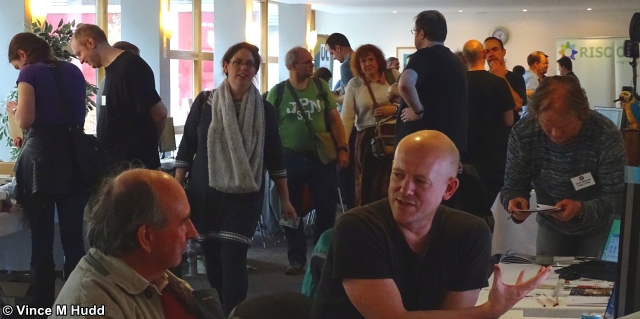
Adrian is also the developer behind Geminus, which also first appeared for the Iyonix, offering features such as graphics acceleration, screen rotation (useful for monitors that could be used in ‘portrait’ mode), and more. Like Aemulor, Geminus has also been further developed and built upon, and is now the basis of graphics acceleration for the i.MX6-based ARMSX ARMX6 from R-Comp, and (I believe) in development for Elesar Ltd’s Titanium.
However, Adrian has also been developing something new, an application called eVince, which was unveiled at the show.
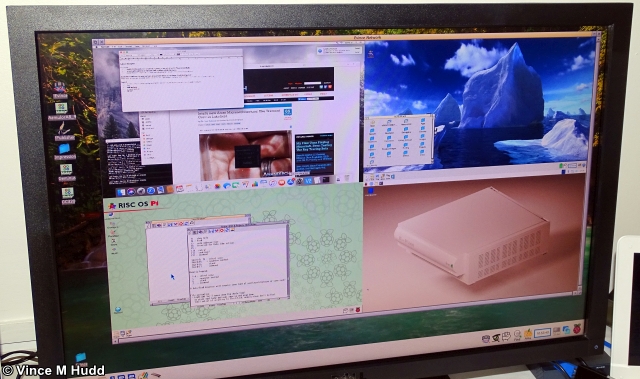
From the name you could be forgiven for thinking it’s an emulation of yours truly, but it’s really a very nifty piece of software to allow other computers on the network to be operated from the RISC OS machine on which it is running. This is done using the VNC protocol, so it is in effect a VNC client – but it’s a VNC client on steroids, with a number of impressive and potentially very useful features, such as side-by-side operation, so that multiple platforms set up next to one another can all behave and operate as one, controlled from a single keyboard and mouse, with no need to switch them between machines.
Drag ‘n Drop
Chris Dewhurst made a welcome return to RISC OS shows with a new issue of on-off-on-off-under-new-management PDF magazine Drag ‘n Drop.
Volume 10 issue 1, dated as Autumn 2019, includes a selection of recent news, three type-in listings (two of which are games, and one a clever graphic utility to apply Lichtenstein-style fills to Drawfile objects), and a feature on using FFmpeg from the command line. At the show it could be purchased on a USB flash drive along with all of the back issues of the magazine, but it can also be ordered individually from the Drag ‘n Drop website, or via R-Comp’s !Store.
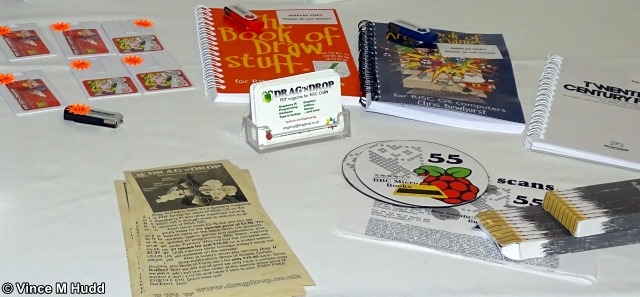
Chris also had available his various books, such as the Book of Draw Stuff and Book of Arcade Games, his CD containing 55 BBC Micro Books, and the 20th Century Font collection.
RPCEmu
Matthew and Peter Howkins were demonstrating RPCEmu, the cross platform RiscPC emulator. The latest version, released on the day of the show, includes a number of changes – but the one many people will see as most significant is a change to the software’s network configuration, which significantly reduces the effort of setting the software up to access the network to which the host computer is connected, and therefore the internet.
Other changes include some GUI niceties, such as a built-in screenshot facility, improvements to HostFS, with certain commands now returning an error if part of the path is invalid (previously, this could result in files being saved somewhere unexpected, for example, with elements of the path and/or file name meaning different things on other platforms).
The software is free to download, but at the show it was available to buy on CD, with proceeds going to Combat Stress – a charity that helps veterans with mental health problems such as post-traumatic stress disorder, brought about during their time serving Queen and country – with the end result being £81.10 heading their way.
3rd Event Technologies
Quincy Coleman, aka qUE, of 3rd Event Technologies was demonstrating a music sequencer that has its origins on RISC OS, the A3000 in particular. Its story began around twenty years ago, when qUE wanted to produce studio-grade sound, but was hindered by the facilities of the computer and the tracker software he was using – limited to low-fidelity sound samples, and no support for MIDI.
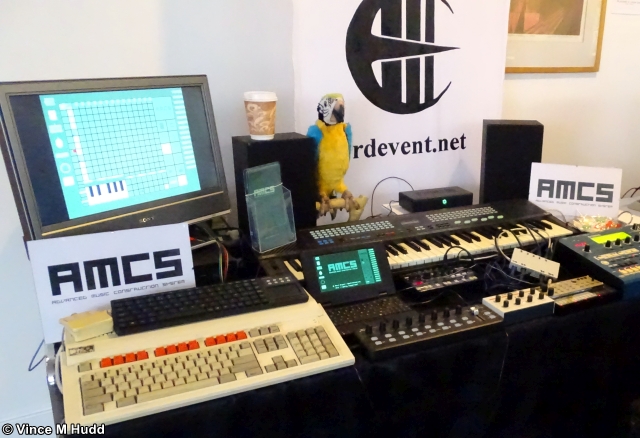
With initial development work in BBC BASIC, and then the language’s built-in assembler, all these years later the RISC OS platform and its included language still provides the build environment for a piece of software that has come along way from its early versions; it now includes its own operating system and therefore replaces RISC OS when it’s run on its original target machine, rather than run as a piece of software on that OS.
Since the software doesn’t need a host operating system to run, it can be ported to other platforms – and that is exactly what qUE has done, with the first non-Acorn target being ARM-based netbooks from Wondermedia, a subsidiary of VIA Technologies. However, the netbooks in question are no longer produced, so the software has now been ported to a VIA Technologies APC8750 board, and can now be purchased as part of a hardware system with that board at its heart – the AMCS WW7 workstation.
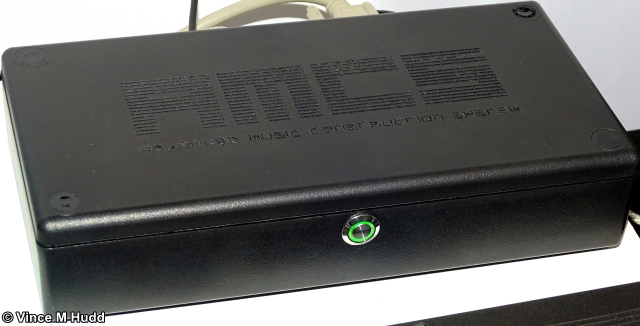
The product comes in the form of a dedicated box, a robust case measuring 22cm by 11cm by 4.4cm, which contains the APC8750 board, a handy 512MB RAM, four USB ports, VGA and HDMI outputs, and so on. The software element, AMCS itself, provides a powerful music creation tool with elements that hold true to its tracker inspiration, and many that set it apart – such as featuring up to 256 variable loops, rather than a number of set-length patterns, which are blended with a mixer that can hold up to 256 arrangements, and so on.
Organizer
Stepping into the side room, North One Communications Ltd had the first stand, where Cut-me-own-throat Dibbler Nigel Willmott was showing off Organizer, the – no THE – personal organiser for RISC OS, and selling it in its ‘on a Stick’ form.
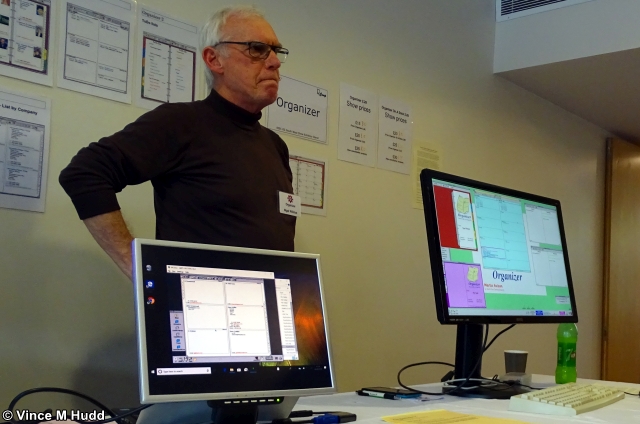
Organizer on a Stick is supplied on a USB flash drive, fully installed and ready to run in a copy of RPCEmu, set up so that it can be plugged into any old PC, thus giving you access to your diary and address book anywhere there’s a suitable PC available to use. The data held by the application can, of course, be encrypted – which is quite important, what with the ‘on a Stick’ version being carried around on a USB flash drive – and the software includes a wealth of features to help you organise your life.
BBC Media Preservation
Depending on your age and your TV viewing habits, you may have seen graphics and other effects produced by Acorn computer systems in programmes you’ve watched – and that doesn’t necessarily mean programmes about computing, but also in other more every day shows; the on-screen graphics for the National Lottery, for example, or various phone-in/on-screen games used in children’s television shows.
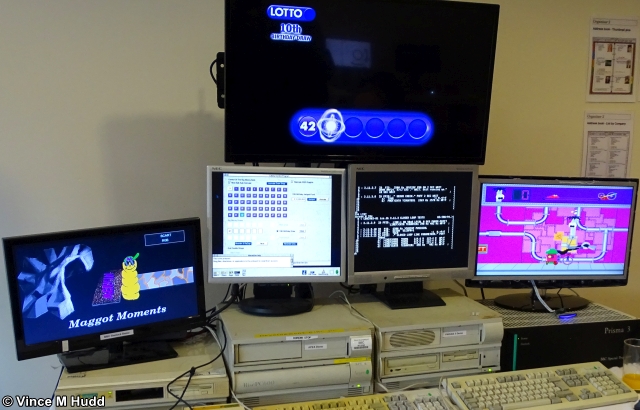
Acorn kit was, for a time, the go-to hardware for the BBC when it came to producing such graphics and, having obtained a good deal of this hardware and software a few years ago, Paul Emerton has undertaken the task of restoring it for use in exhibitions (such as this one) and to ensure this equipment, with its historical importance, didn’t just finish up gathering dust in a cupboard, or worse.
Acorn systems have also been used in the aerospace industry, where Keith Emerton (Paul’s father) worked as a Senior Specialist Test Equipment Engineer. As the process of testing using computers became a key part of the process, Keith and his team settled on Acorn computers on the basis that they were robust and reliable, and would stand the test of time, and testing systems were thus developed around them. Amidst Paul’s selection of hardware and software that came from the BBC Special Projects division, one was also running some of the software Keith used in his role.
CJE Micro’s and The Fourth Dimension
I usually refer to CJE Micro’s as the little shop with a lot of stock – but after a recent change of address they are now, strictly speaking, a slightly bigger shop (well industrial unit) with a lot of stock – although I’ll probably continue to use the old description for a while.
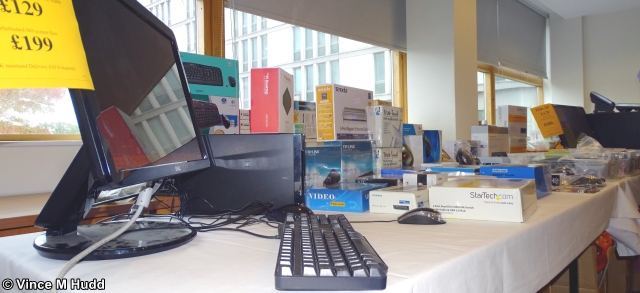
Although that move has been on the cards for some time – Chris Evans included a photograph of the new premises in his talk at the Wakefield Show back in April – it was only formally announced a month prior to the London Show. This has, understandably, kept them busy, which is why there were no significant announcements from the company in the run up to the show. However, that didn’t stop them from bringing along their usual selection of stock, with everything from small but handy components, all the way up to monitors and computers – so, as usual, if there was something you specifically needed, there was a good chance Chris Evans and Andrew Conroy would have been able to supply it to you on the day.
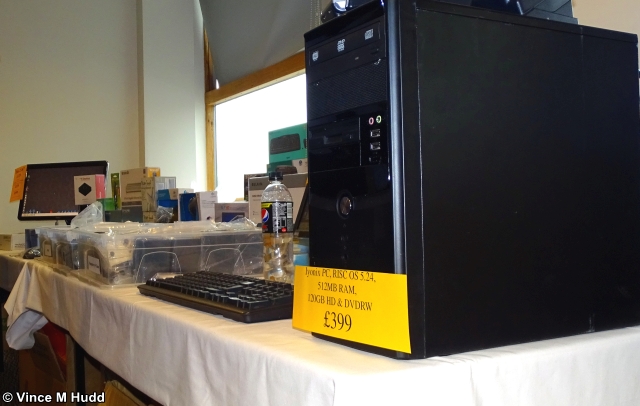
Chris took to the show theatre to give one of the day’s talks, and he once again made use of the projector to show a series of slides – mainly photographs of the products he wanted to talk about – and made use of the RISC OS-compatible combined mouse/laser pointer introduced earlier in the year.
Although there were no new products or significant updates announced in the run up to the show, many of the products he talked about were new to the event, including the very tool that has, it would seem, prompted this change of approach; that combined mouse/pointer.
RisControl
The final side-room exhibitor was Neil Fazakerley with his RisControl goodies.
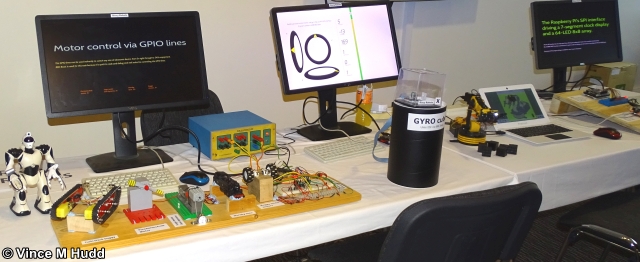
Billed as Riscy Robots on the London Show website, that’s arguably a bit of a misnomer, because Neil had fewer robot-related exhibits than he sometimes has and, like last year, more general interfacing – although that isn’t to say there was no robotic element to the display; as well as a menacing looking robot at one end of the stand (but fortunately for us, its builders lacked a sense of scale – although there was no danger of it being swallowed by a small dog), there was a robot arm that visitors could control via a RISC OS control program.
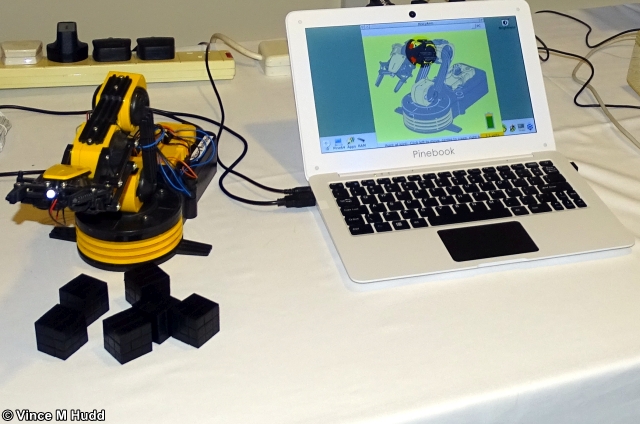
Amongst the non-robot exhibits were a range of motors, such as a Hornby locomotive and a Lego motor, all being controlled – as far as I could make out – from a single Raspberry Pi, via the GPIO pins and a BBC BASIC program. The Gyro cube, on the other hand, is about monitoring rather than controlling, and the BBC BASIC program reads the information provided by a gyroscope in the cube, interfaced to a Pi, to indicate the orientation of the cube.
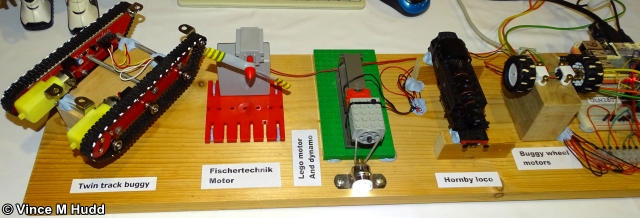
Finally, another pair of Pis were being used to separately control small light boards; in one case a light-chaser, and the other both a LED array and 7-segment display.
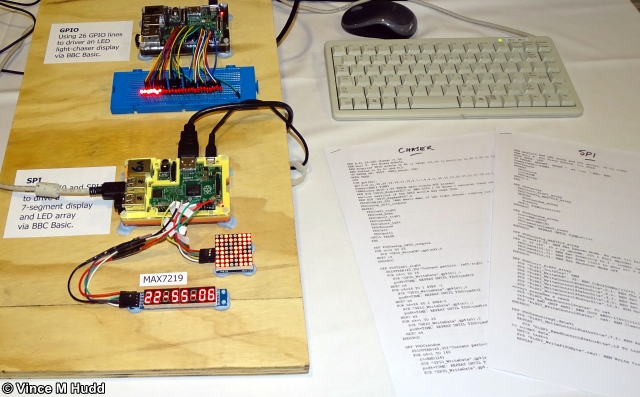
Wi-Fi Sheep
Tom Williamson and his partner Anna were next, representing Wi-Fi Sheep and Ident Computer.
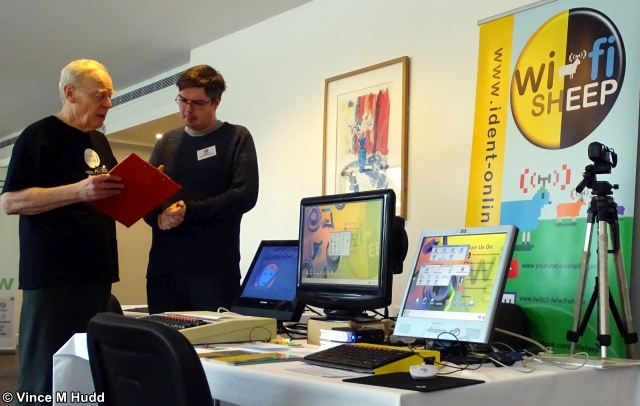
As Ident Computer, the pair introduced the RISC OS world to the Micro One kit computer only a few short years ago, before all-but taking the design out to pasture when they introduced the 3D-printed RiscCE, which comes in a variety of versions according to the target operating system and intended use.
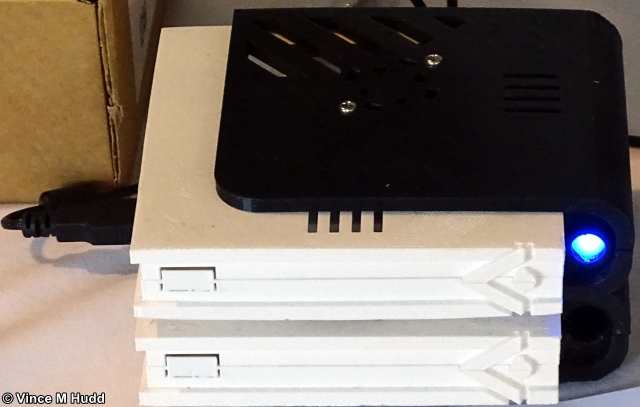
Since then, the original kit computer has made something of a return, now as the Micro 1.5 – but only in design form; it’s now supplied as a PDF file with build instructions, and the plans that can be printed in order to cut the materials to size. The materials themselves (along with any components, such as the keyboard and a Raspberry Pi) aren’t included – they need to be sourced separately.
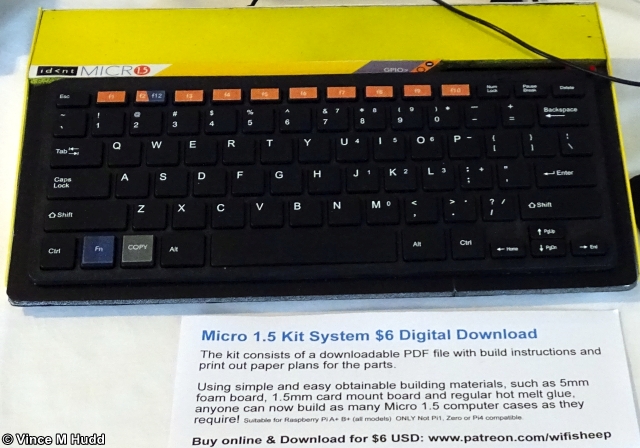
And how do you get your hands on the design file? By subscribing to Wi-Fi Sheep on Patreon. Wi-Fi Sheep is an online show provided originally as podcasts, but now as a YouTube channel, and the Patreon subscription is a way to support the channel, along with subscribing via YouTube.
The channel provides content that isn’t always related to RISC OS, but our operating system does get coverage (and therefore exposure to people who may not already know of it) – for example, AMCOG Games has featured from time to time, and the very show this report is about has had a video report made available on the channel, edited from recordings made by Tom on the day with some additional commentary.
And if you want to know more about Ident and Wi-Fi Sheep, Tom took one of the theatre slots at the show, to talk about the channel and his plans for the future. Those plans include the possibility – currently under consideration, so not definite – of selling the design file for the RiscCE so that customers can print it themselves if they have (access to) a suitable 3D printer.
Work is also under way with RISC OS Developments on two fronts. Firstly, RISC OS Developments will in the near future be releasing a ‘stock’ build of RISC OS that incorporates features from the Ident/Wi-Fi Sheep build (and will replace that build when it is released), which will be branded as RISC OS Direct – and secondly, under the same branding, there will be a video series produced by Wi-Fi Sheep to showcase the operating system and what can be done with it.
Daryl Dudey
Next came a new exhibitor to the London Show – Daryl Dudey, a RISC OS user of old who has recently returned to the platform thanks to the Raspberry Pi, and is developing a 3D graphics engine, which Daryl expect to be usable from any programming language.
The origins for the engine lie with the desire to develop an Outrun-style game. For those unfamiliar, Outrun was a racing game, rendered in a 3D perspective with the ‘camera’ being behind the car controlled by the player, and the track – in fact the road – extending out in front, and the 3D-rendered scenery scrolling from the distance in front past the player on either side.
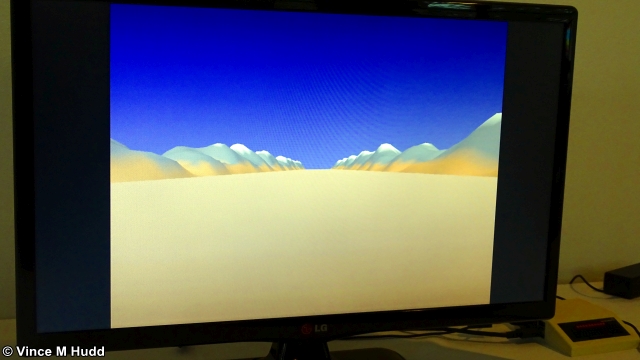
Although there wasn’t a playable demonstration of the game, because work has concentrated on the 3D-engine, Daryl was able to show a proof-of-concept of the type of scenery rendered with the engine, as well as other demonstrations of what the engine could do. The various models demonstrated could be rendered in a number of different ways, with and without smoothing, as wire frames, and so on, as well as rotated and viewed from any angle.
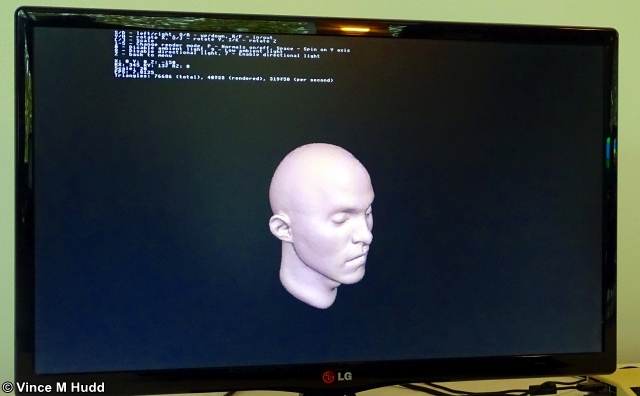
RISC OS Open Ltd
At the far end of the main room, RISC OS Open Ltd (ROOL) could be found, represented at London by Steve Revill and Rob Sprowson – who were also acting as models for the company-branded tops that were available to buy.
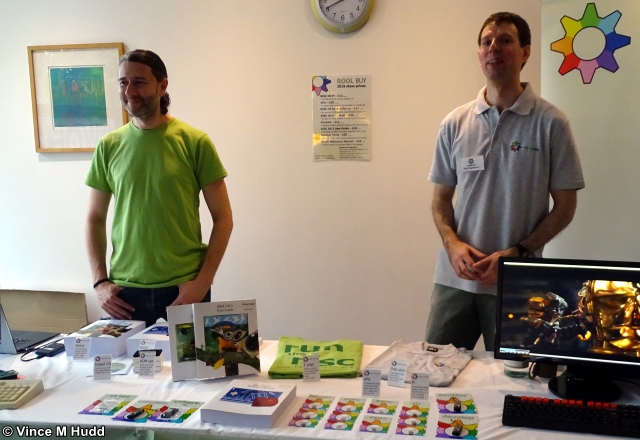
One was a T-shirt that came in a shade of green (as close a match that could be found for the shade of green favoured by ROOL on the website) with the words ‘run the risc’ emblazoned on the back, and the other was a grey polo shirt with the company name and logo on the front-left breast, which makes anyone wearing it look like a member of staff!
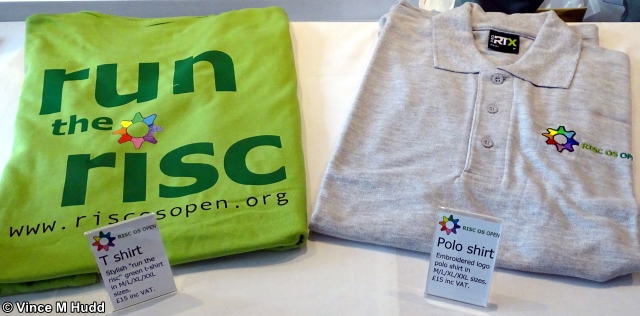
ROOL looks after the main source tree for RISC OS, with pre-built versions available to download for free or, to support the company financially, buy at shows. Other useful items they offer include a growing range of manuals and other items, so the stand was well stocked as usual – although (other than the tops) I don’t think there was anything new for this show.
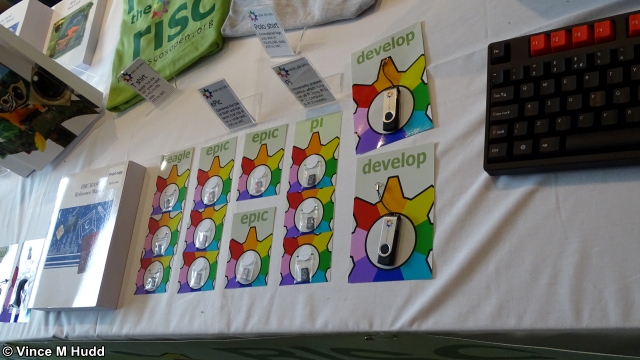
ROOL’s theatre talk was delivered by Steve Revill, covering things that have happened in the ROOL-sphere over the last year or so (such as the move to Git lab for source control, much of the HardDisc4 disc image being repackaged in PackMan so that it’s easier for users to upgrade individual components and applications, and so on), as well as the company hopes to achieve (or see) in future; support for the Raspberry Pi 4, which is in progress, multi-core support, and so on.
When he’s not acting on behalf of ROOL, Rob Sprowson also runs Elesar Ltd, and shortly before the show had released a rather handy new hardware product for the Raspberry Pi, which was also on show on the ROOL stand (as well as being used on the ROUGOL stand, mentioned earlier).
Although it complies with the HAT standard for the Raspberry Pi, Elesar’s board is a hardware product exclusively for the RISC OS market. The Pi has itself had on-board Wi-Fi for some time now, but the current version of the RISC OS network stack is unable to take advantage of it, forcing RISC OS users to either connect to their networks using an ethernet cable, or using some other solution such as Wispy from RISCOSbits or PiFi from R-Comp.
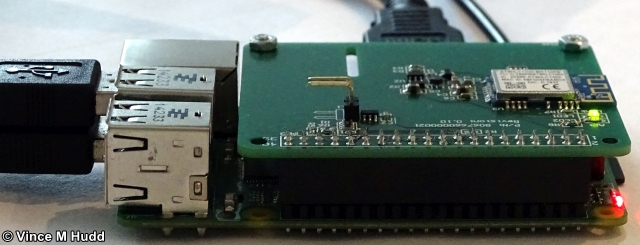
The solution from Elesar is a small board that includes all the necessary components on-board, including a network stack, to which control software on RISC OS interfaces. This then provides the sort of facilities that are customarily seen on other operating systems, allowing nearby networks to be seen and connected to, and so on. Being a Raspberry Pi HAT, though, means it is only suitable for RISC OS users with a Pi – so for users of other hardware, the other solutions are still the best way to achieve wireless networking.
University of Cantabria
Late last year, a piece of software called UCDebug was spotted on GitHub, and not long after one of its developers, Pablo Fuentes, joined the RISC OS Open forum to offer an explanation of the software – an ARM debugger, which was developed at the University of Cantabria, near Santander in Spain, as part of its curriculum covering computer architecture.
A little under one year later, the University was represented at the London Show by Pablo, where he was explaining to visitors not just the features of the software, but also how the University came to be using RISC OS in the first place. It was previously teaching Computer Architecture using MIPS, but that presented problems (including a lack of interest on the part of students), and in looking for an alternative they settled upon the much more relevant ARM architecture, the Raspberry Pi as a hardware base due to its low cost and widespread availability – and RISC OS because of the ease with which it allows developers to interact more directly with the underlying hardware.
For a full explanation, Pablo gave one of the day’s talks covering all of the above and more. Interestingly, while the University is just under the national average in Spain in terms of size, he says its degree course in Computer Science is considered to be one of the best in Spain – and is taken by around four hundred students each year. That means more people are likely to be exposed to RISC OS at the university than we typically see at our main shows here in the UK.
Chris Hall
Moving along, the next exhibitor was Chris Hall, with a selection of hardware and software on display.
His hardware includes his portable GPS unit that is based around a Raspberry Pi and features both PaPiRus and OLED displays, designed to run off battery, cyclically powering up, obtaining a GPS fix, then powering down again in order to save power, and thus allowing a course to be tracked over a prolonged period with no mains power. The route is kept in GPX format, which can be subsequently read into any mapping software that supports the format, such as Sine Nomine’s RiscOSM.
Another Pi-based hardware project is a data-logging system, again designed around a Raspberry Pi, this time to monitor signalling circuits on the Severn Valley Railway. Like the GPS unit, this device is entirely self-contained and can run off a battery – and in both this and the GPS unit can be connected up and used as a normal RISC OS computer, allowing easy access to the data they’ve recorded.
FamTree is Chris’ software for generating a family tree from data held in the tree-structure provided by the computer filing system – each subdirectory level representing a generation, and each individual subdirectory representing a person – and this was available to buy on USB flash drive.
Tricky Gaming
Richard Broadhurst – aka Tricky – was next, providing retro-gaming fun for users young and old on the Tricky Gaming stand, with software running on a range of BBC Microcomputers.
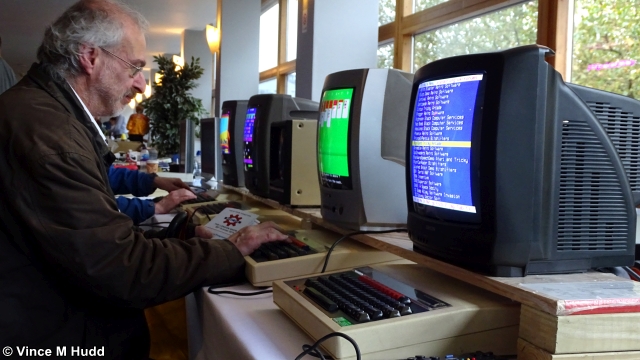
Games running included new versions of old titles, such as Carnivale, Richard’s own version of a 1980s Sega classic, which improves upon the original BBC port of the game from Acornsoft, which apparently was a bit of a disappointment.
Another worthy mention goes to Stunt Car Racer, a 3D perspective stunt driving game that was also running on one of the machines. The original version was written by Geoff Crammond, who wrote a number of titles for the BBC Micro, but this particular game never made it to the Acorn platform – until earlier this year when a version was ported by the Bitshifters Collective, which by all accounts presents a better all round experience on the Acorn 8-bit than some of the other platforms on which it runs.
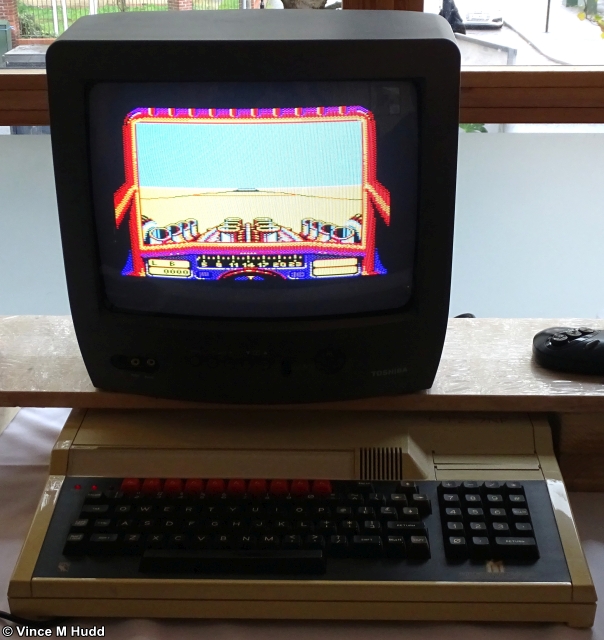
Rob Coleman
Showing off a superb upgrade to the BBC’s graphics capabilities, Rob Coleman was the next exhibitor with VideoNuLA, his hardware upgrade for the 8-bit computer to greatly enhance its graphics capabilities with a palette of 4,096 colours, improved scrolling, and other improvements.
Rob also had a port of Doom running on a BBC, although this is done by using a Raspberry Pi as a co-processor – but even with that caveat, it’s still an impressive feat.
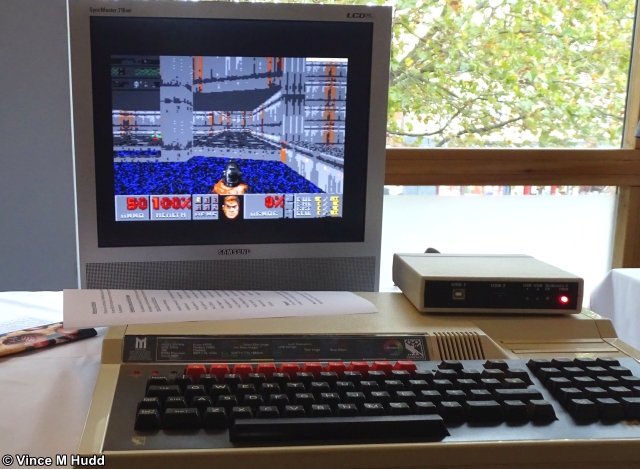
Jim Russell
Next door to Rob, Jim Russell had brought along a BBC Micro running something even more impressive – a port of RISC OS to the 6502 processor!
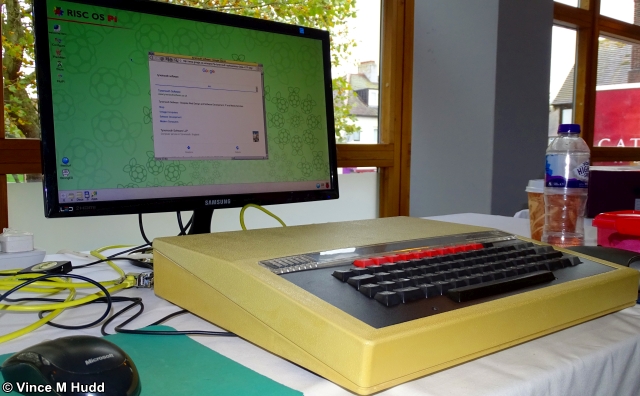
Well, okay, that isn’t quite true: Jim actually had what appeared to be a BBC Microcomputer running RISC OS, but if you looked under the skin was actually a Raspberry Pi in a BBC case, suitably interfaced so that when the lid was on only a trained eye could spot that there was anything afoot. Well, ignoring what was on the screen, anyway – there was a fairly big clue there, obviously!
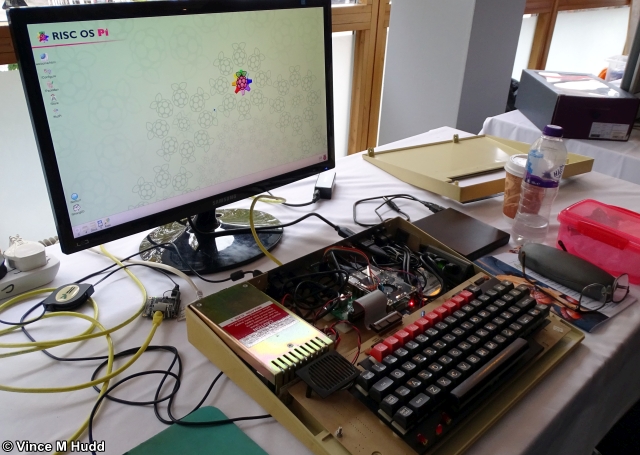
That same BBC Micro could also run Linux if a switch at the back was flicked before booting up – wired to a handy ‘2in1’ device that plugs into the Raspberry Pi’s SD-card slot, and allows either one of two inserted cards to be selected via said switch. All very neat!
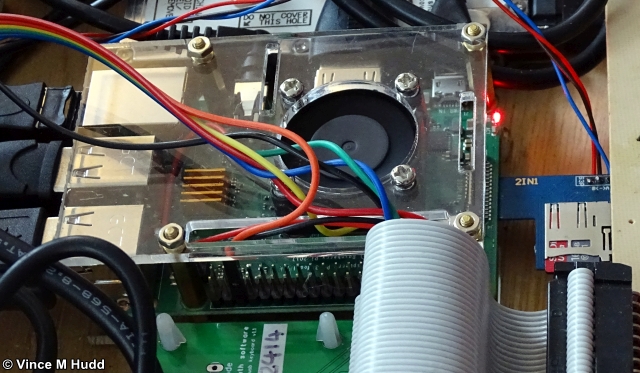
Charity Stand
The charity stand came next with a wide range of hardware and software, books and magazines, and anything else you can care to imagine that has some relevance to RISC OS computers and their users – and probably even things that don’t!
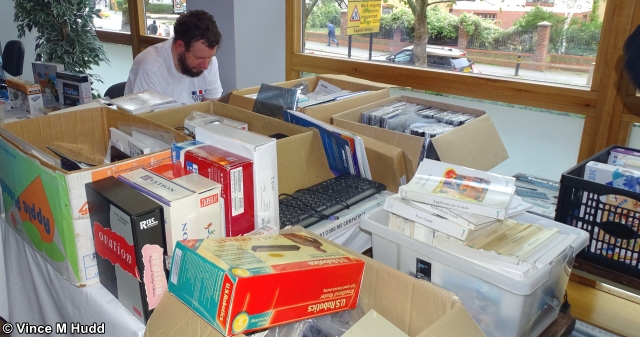
The stand was raising money in support of Combat Stress, which provides support for veterans suffering mental health problems resulting from their time in service, such as PTSD and so on.
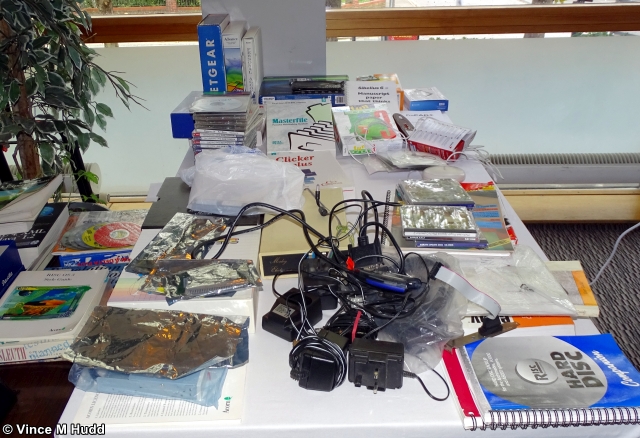
Visitors to the show could therefore support the charity – and thus those veterans – by purchasing something from the stand, donating old items for others to buy, or simply donating a bit of spare cash.
Archive Magazine
Jim Nagel was at the show, having missed Wakefield in April – and he even had a brand new issue of Lesser Spotted Archive Magazine with him, making it quite easily spotted on this particular day!
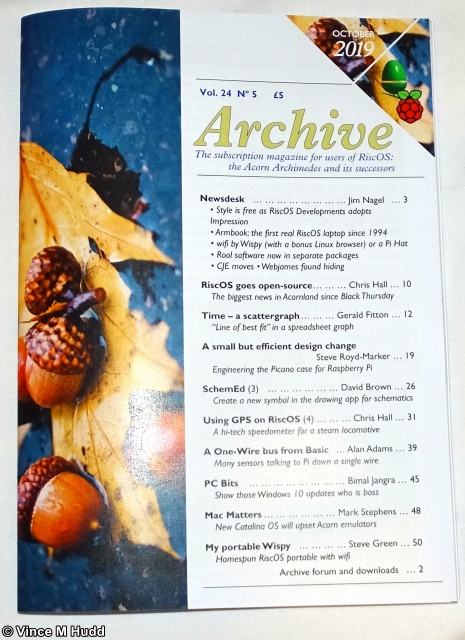
Subscribers who attended the show could pick up their copy of issue 24:5 on the day, while those who didn’t come along will have received them in the post a little later. The other group are people who came to the show but who aren’t subscribers, and they had the opportunity to fix that oversight on the day by stumping up the necessary amount of money.
Orpheus Internet
Richard Brown should have been manning the next table, representing Orpheus Internet, the most RISC OS-friendly ISP there is, but was unfortunately unable to make it on the day. So…
Impression X
…moving on to another Richard, this time of the Keefe variety, the next stand was the ideal port of call for anyone interested in Impression-X (website still MIA).
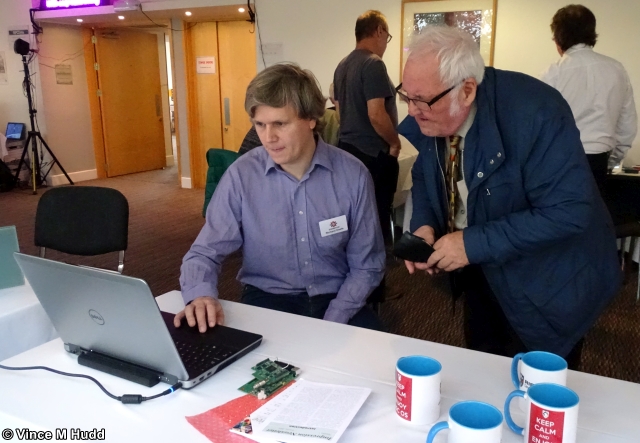
Originally developed by Computer Concepts, the Impression family was taken over this year by RISC OS Developments Ltd (from its more recent owners X-Ample Technology). Richard has been working on the software for a few years now in order to make it 32-bit compatible – a big job in and of itself, made all the more difficult with the source code for some original components missing, meaning they will have to be rewritten from scratch.
At the London show, Richard had the latest beta version of the software available, and was able to answer questions about how much of the 32-bit conversion he has done so far (a surprisingly large amount) and how much is still to do (an unsurprisingly much larger amount!) He was anticipating the release of a new version some time after the show with some new Postscript-related features added.
RISC OS Developments Ltd & R-Comp
Since the formation of RISC OS Developments, the company’s table at RISC OS shows has traditionally either been the Orpheus Internet table doubling up, with Richard Brown fielding questions, or one placed between Orpheus and R-Comp, thus allowing Richard and/or Andrew Rawnsley to look after things between them as and when necessary.
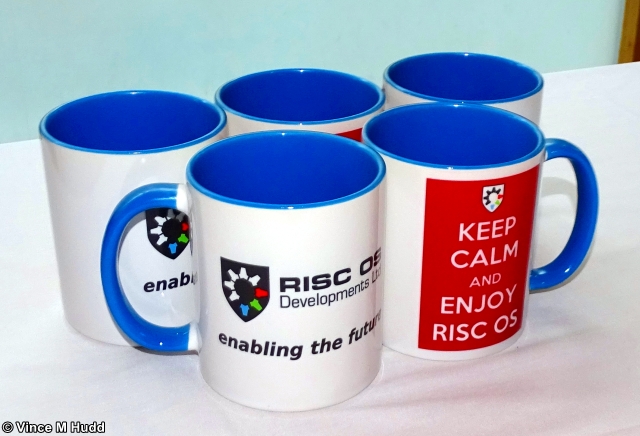
This time around a separate space had been set aside for the company, but with Richard absent, the responsibility fell entirely to Andrew – and with Andrew also giving a joint RISC OS Developments and R-Comp talk, it makes sense to deal with both companies in one go.
For RISC OS Developments, it makes sense to concentrate on that talk – not least because Andrew spent so much of his allotted time talking about this side of things that he just about ran out of time before he got around to saying anything about R-Comp!
A large part covered the web browser developments – the very project that led to the company being formed in the first place. Beta versions of the two main browsers being worked on were made available to shareholders in the week prior to the show, and Andrew demonstrated both. He also covered how and why they came to take over the Impression family.
Interestingly, it seems they have negotiated to release two other programs free to RISC OS users, although Andrew wasn’t sure if he could say what they were, so erred on the side of caution and opted not to do so. He did say, though, that one was networking related, the other programming related, and that they are programs people would be familiar with. Support has also been provided for a port of Python 3.8 to the platform, although this is not yet ready for release.
On the subject of the video series to be produced with Wi-Fi Sheep, mentioned by Tom Williamson in his talk, Andrew explained that these will include one that covers setting up and flashing an SD-card for the Pi, as well as others explaining how to do particular things in RISC OS – including hints and tips that may also be useful to seasoned RISC OS users. The videos will appear on YouTube, but will be available as downloads as well. And on the RISC OS distribution, also mentioned by Tom, it will be designed around a larger card than the standard 2GB card image provided by RISC OS Open Ltd, and should include a bigger range of software in order to offer new users a greater first experience – and he also hopes that they’ll be able to attend Raspberry Jams and give away SD-cards with that distribution on them, all ready to just insert and boot.
Covering R-Comp, Andrew only left himself enough time to mention two things. The first of these was ARMBook, an ARM-based laptop that runs RISC OS natively; this first appeared at the London Show last year, and is sold by its manufacturer as an ARM-based Linux computer. That manufacturer became interested in having RISC OS run on it as an option after the OS was acquired by RISC OS Developments and then made fully open source under the Apache licence.
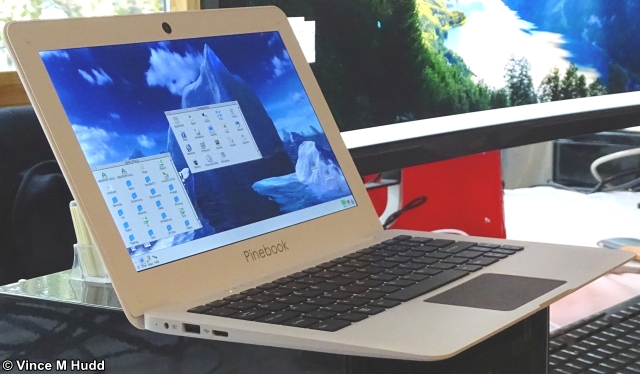
The second thing he mentioned in the talk was LockScreen, a software solution to locking down RISC OS computers so that a password is required at start up, and whenever a computer is left unattended – which, apparently, came about because a commercial customer needed such a solution.
However, the R-Comp stand had a little more of interest than just those two items. Shortly before the show, the company announced another new laptop in their RISCBook range, which are Windows machines that run RISC OS via an emulator, all nicely configured so that they are ready to use. The new machine sports a 17inch IPS screen running at 1920×1080, a quad-core eight-thread i5 CPU, 8 or 16GB RAM, and more – and, of course, they were available to look at, and even buy, on the day.
New versions of NetFetch and Messenger Pro had also been released in the run up to the event, although these were only ‘point’ releases. In the case of NetFetch, the update was primarily to resolve an issue with one of its component applications, Hermes. The new version of Messenger Pro, though, not only saw some minor fixes, but other improvements as well – including better disc access, which is significant on machines with slower disc systems.
Another point of interest on the R-Comp stand was something Michael Grunditz is working on, though not on behalf of R-Comp. He’s been busy porting RISC OS to a RockPro64 board, which is based around a Rockchip RK3399 SoC – an interesting creature that features both a Cortex-A72 processor and a quad-core Cortex-A53.
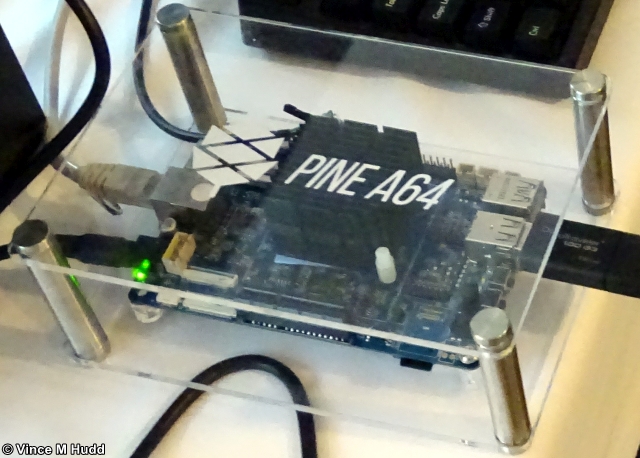
On the day, only limited progress had been made, and he was talking to the board through another machine – but in the period since the show things have moved on. Strictly speaking, though, what has happened since isn’t show news, so I’ll just drop in a link to a discussion on the ROOL forum, along with a link to Michael’s Twitter feed, where he has been initially posting screen grabs and comments on the subject.
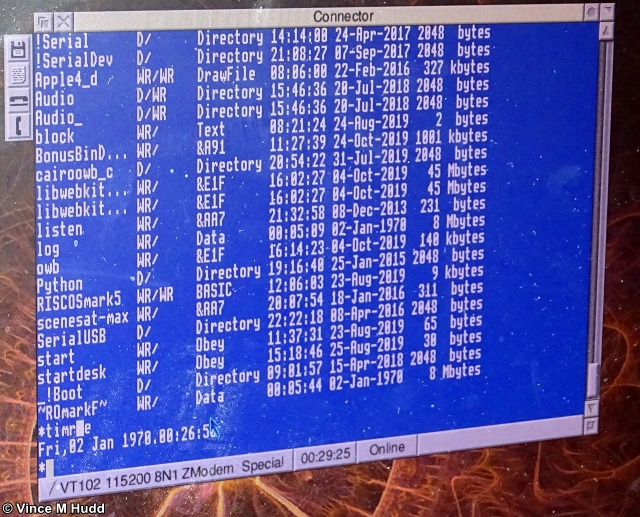
AMCOG Games
The penultimate exhibitor was Tony Bartram and AMCOG Games, with yet another new game available to buy.
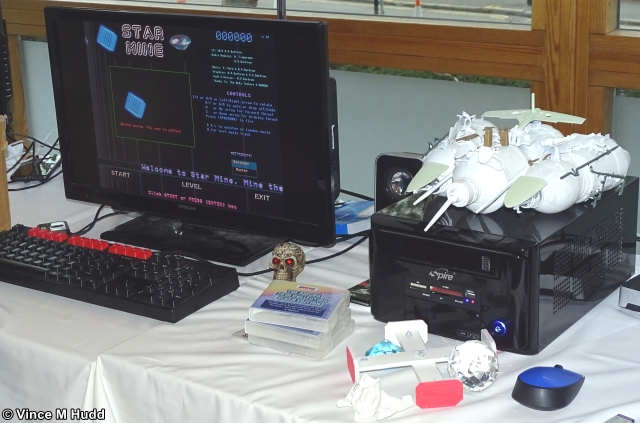
The game is a 3D-perspective space game called Star Mine, which became available for non-show goers (grr!) to buy from !Store about a month later. The game is based around the same 3D-engine developed for the zombie game Island of the Undead, and as well as the usual features that can be expected from one of Tony’s games – great graphics, high quality music tracks and sound effects, etc., with full source code included so that people can learn and take ideas and inspiration from it – this game also has in-game objects that also exist in the real world.
Sort of.
Some of the in-game objects were produced from photographs, taken from various angles, of physical objects – in that sense, yes, they exist in the real world. However, while some of those real world objects already existed (such as a child’s toy), others were brought into existence for the purpose, including a model built in a very Blue Peter fashion out of plastic bottles and other objects, with aid of a touch of glue, and given a splash of paint to finish.
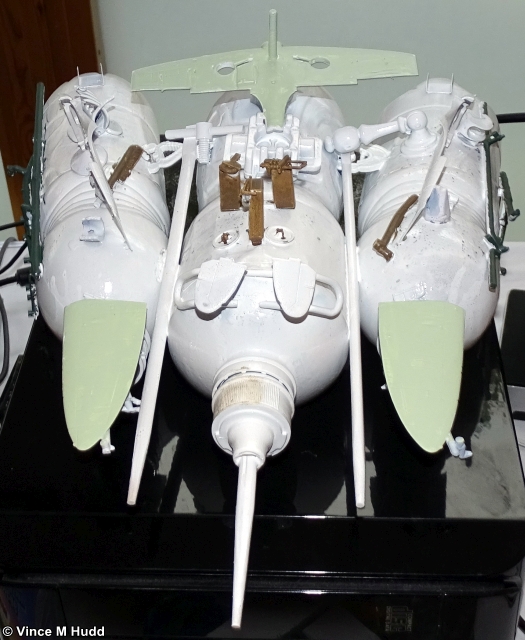
RISCOSbits
And the final exhibitor was Andy Marks, aka RISCOSbits, who had brought along a wide range of goodies from his ever expanding range – complete, in some cases, with entertaining names that can be as much a discussion point as the items themselves.
One discussion of names came about prior to the item itself, when at the Wakefield Show (after seeing a stack of machines, largest at the bottom, smallest at the top) I suggested to Andy the name PiROmid – and for the London Show, Andy therefore produced exactly that.
The name obviously began with the point that the stack of machines looked like a pyramid, but with the letters ‘r’ and ‘o’ in the middle capitalised as the initial letters of RISC OS, and the ‘py’ at the start changed to ‘pi’ to represent the Raspberry Pi – but the Pi wasn’t the only computer in the original stack, nor the actual PiROmid produced for the show.
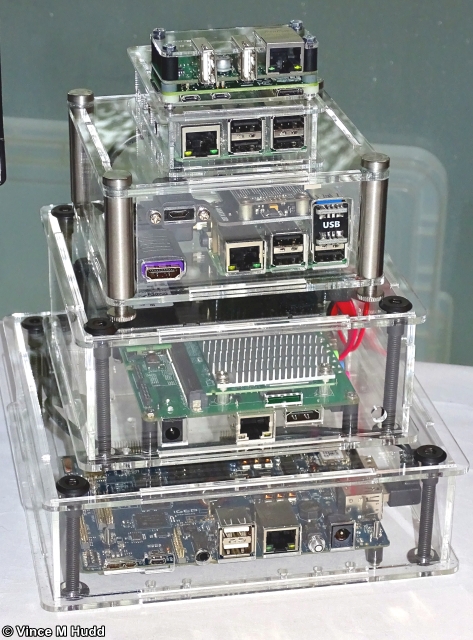
The top three layers in the final version of the PiROmid were Raspberry Pis (a Zero a the very top), above a Qadro (a Wandboard Quad – as used in R-Comp’s ARMX6), with a Uniq-Ace (containing an IGEPv5) at the bottom. And as the picture shows, it looked very snazzy indeed, and would turn the contents of any desk into yet another talking point, along with the names of some of Andy’s various cases and machines!
Other goodies on the stand included the PiSSDup (an SSD storage upgrade for the Pi), the ROkit (a Pi-based kit computer), the si.zeRO (a Raspberry Pi Zero with full-size ethernet and USB ports in a tiny case), and much more.

So that was RISC OS London, 2019 – yet another great show, and I look forward there being another next year. In the meantime, the next two shows in the UK are the Southwest Show, which will take place on Saturday, 22nd February at the Arnos Manor Hotel in Bristol, and the Wakefield Show, set for Saturday, 18th April at the Cedar Court Hotel. On Saturday, 16th May, RISC OS users in mainland Europe could consider heading towards Koog, near Amsterdam – that’s when the next RISC OS eXperience (English translation) takes place.
Until then, look at some more pictures.
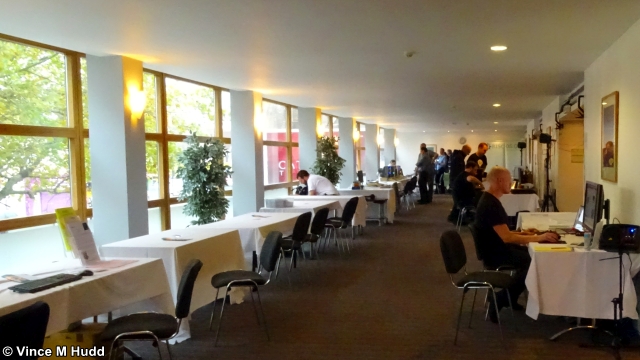
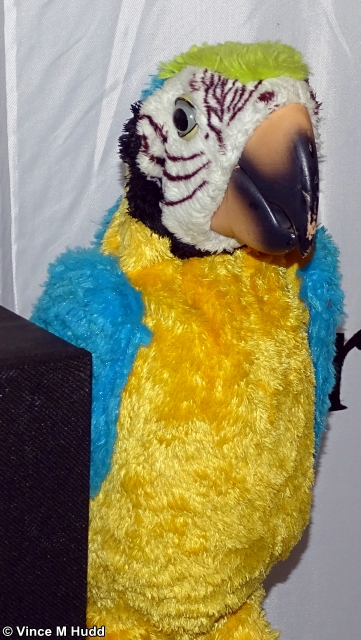
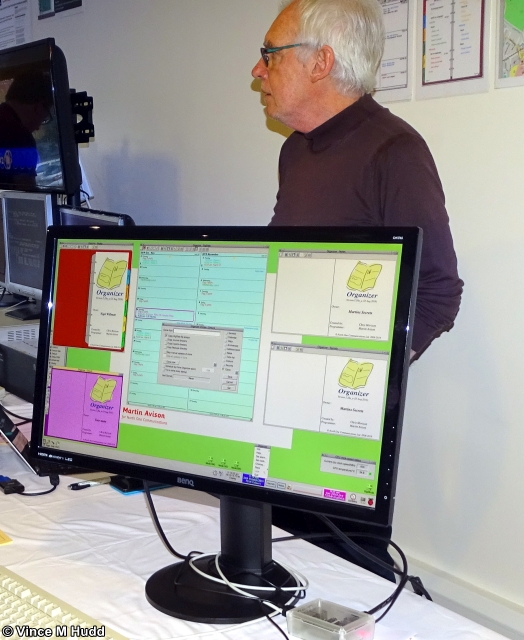
Oh, wait, that’s Nigel Willmott, there to discuss Organizer!

